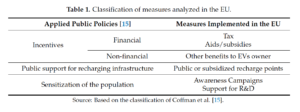Despite its environmental benefits, the amount of Electric Vehicles (EVs) in use within the European Union 28 is still very limited. Poor penetration might be explained by certain factors that dissuade potential buyers. To balance these factors and promote electro-mobility, EU Member States have established incentives to increase demand. However, the various measures are scattered.
A new research paper by Cansino et. al. (2018) contributes to fill the gap in the literature by offering an overall view of the main measures. The authors focus on measures to promote electro-mobility within the EU28 until 2014. After an in-depth and comprehensive review of the relevant measures, the authors conclude that the most important policy instruments to promote EVs are tax and infrastructure measures in addition to financial incentives for purchasing and supporting R&D projects.
Tax
Regardless of the scarcity of EV registration data, the available information allow the researchers to conclude that higher EV penetration levels appear in countries where the registration tax, the ownership tax, or both taxes have developed a partial green tax by including CO2 emissions in the calculation of the final invoice.
The vehicle age could be included as an additional parameter to calculate the final invoice for ownership tax. This could facilitate the replacement of older and higher polluting vehicles by newer and less contaminating EVs.
Commercial vehicles
The ownership tax applied to commercial vehicles could include CO2 emission levels when calculating the final invoice. This is particularly important because such vehicles are the most fuel demanding and the most responsible for CO2 emissions when using internal combustion motors.
Growth in e-commerce ought to lead to increasing use of EVs for parcel deliveries in urban areas. Measures to support EVs could be seen as a part of the effort required to meet the delivery services offered by e-retailers.
EVs could become part of future smart electricity systems in a twofold sense. First of all, their batteries could be considered as a disperse storage system for better management of demand peaks. Lessons learned from vehicle to grid pilot projects would be useful. Second, if a dynamic tariff system is deployed at the national level, different prices of electricity for charging EVs could reduce the risk of disruption by enhancing power capacity.
Communication
Communication programs could play a crucial role in promoting electro-mobility through two ways. First, misperceptions of the main advantages of EVs could be reduced through adequate information programs co-funded together with private companies. Second, remarkable efforts in communicating available public incentives could help to shift potential consumers to EVs from other, more contaminating options.
Source:

